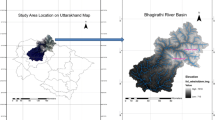Abstract
Climate variability, particularly, that of temperature and precipitation, has received a great deal of attention worldwide. In the present work, we have carried out a thorough statistical modelling of precipitation and temperature extremes by taking century-long (1901–2002) datasets into consideration for Himachal Pradesh, India. Globally, the patterns of extreme weather events have changed from longer and hotter heat waves to heavier rains. A fragile ecosphere, climatic change, and the unique geology of Himachal Pradesh have all led to a sharp increase in natural disasters in the hill state over time. The climate of the state varies by altitude. Since precipitation and temperature are the main driving forces behind climate change, quantifying these two variables over a range of return periods is crucial in policymaking for minimizing the potential harm brought on by variations in these atmospheric elements. The statistical modelling of the meteorological data and probabilistic forecasting were done using extreme value theory (EVT), an advanced statistical modelling approach that is widely acknowledged. The generalized extreme value (GEV) analysis approach of EVT is utilized for the probabilistic forecasting of the extremities. The extreme values and their probable occurrence are estimated once every 50, 80, 100, 120, 200, 250, 300, and 500 years, respectively. By estimating the probabilities of extreme events, we can better understand the potential risks and impacts of climate change and develop strategies to manage and mitigate these risks.








Similar content being viewed by others
References
E Fischer and R Knutti Nature Clim. Change 6 986 (2016). https://doi.org/10.1038/nclimate3110
L V Alexander et al J. Geophys. Res. Atmos. 111 1 (2006). https://doi.org/10.1029/2005JD006290
B N Goswami, V Venugopal, D Sangupta, M S Madhusoodanan and P K Xavier Science 314 1442 (2006). https://doi.org/10.1126/science.1132027
A Buerkert, E Fernandez, B Tietjen and E Luedeling Clim. Change 162 1399 (2020). https://doi.org/10.1007/s10584-020-02862-8
H M Hanlon, D Bernie, G Carigi and J A Lowe Clim. Change 166 1 (2021). https://doi.org/10.1007/s10584-021-03100-5
G A Meehl, F Zwiers, J Evans, T Knutson, L Mearns and P Whetton Bull. Am. Meteorol. Soc. 81 427 (2000). https://doi.org/10.1175/1520-0477(2000)081%3c0427:TIEWAC%3e2.3.CO;2
B Orlowsky and S I Seneviratne Clim. Change 110 669 (2012). https://doi.org/10.1007/s10584-011-0122-9
V V Kharin, F W Zwiers, X Zhang and G C Hegerl J. Clim. 20 1419 (2007). https://doi.org/10.1175/JCLI4066.1
V V Kharin, F W Zwiers, X Zhang and M Wehner Clim. Change 119 345 (2013). https://doi.org/10.1007/s10584-013-0705-8
S Chen et al J. Geophys. Res. Atmos. 124 11051 (2019). https://doi.org/10.1029/2019JD031016
A Mondal, D Khare and S Kundu Theor. Appl. Climatol. 122 143 (2015). https://doi.org/10.1007/s00704-014-1283-z
M R Bhutiyani, V S Kale and N J Pawar Clim. Change 85 159 (2007). https://doi.org/10.1007/s10584-006-9196-1
S Sen Roy and R C Balling Geophys. Res. Lett. 32 1 (2005). https://doi.org/10.1029/2004GL022201
E Towler, D Llewellyn, A Prein and E Gilleland Weather Clim. Extrem. 29 100260 (2020).
D Koutsoyiannis Hydrol. Sci. J. 49 591 (2004).
D Chikobvu and R Chifurira S. Afr. J. Sci. 111 1 (2015).
W M Thupeng Int. J. Appl. Math. Stat. Sci. (IJAMSS). 8 1 (2019).
S Beguería and S M Vicente-Serrano J. Appl. Meteorol. Climatol. 45 108 (2006).
T-A Sampson and N A Kwadwo J. Math. Stat. 14 275 (2018).
S B Sunday, N S Agog, P Magdalene, A Mubarak and G K Anyam Sci. World J. 15 73 (2020).
H B Hasan, N F B Ahmad Radi and S B Kassim Lect. Notes Eng. Comput. Sci. 2197 181 (2012).
W K Huang, M L Stein, D J McInerney, S Sun and E J Moyer Adv. Stat. Climatol. Meteorol. Oceanogr. 2 79 (2016).
P Naveau, M Nogaj, C Ammann, P Yiou, D Cooley and V Jomelli Comptes Rendus Geosci. 337 1013 (2005).
L G Cao, J Zhong, B Da Su, J Q Zhai and M Gemmer Adv. Clim. Chang. Res. 4 153 (2013). https://doi.org/10.3724/SP.J.1248.2013.153
T A Buishand, L de Haan and C Zhou Ann. Appl. Stat. 2 624 (2008). https://doi.org/10.1214/08-AOAS159
N Varathan, K Perera and N Wikramanayake Statistical Modelling of Daily Extreme Rainfall in Colombo. Int. Conf. Sustain. Built Environ. 2010 (ICSBE 2010), December, pp 13–14 (2010)
S Shahid Theor. Appl. Climatol. 104 489 (2011). https://doi.org/10.1007/s00704-010-0363-y
J Carreau, L Neppel, P Arnaud and P Cantet J. la Société Française Stat. 154 119 (2013).
H Hasan and Y Wai Chung AIP Conf. Proc. 1309 372 (2010). https://doi.org/10.1063/1.3525139
D Maposa, J J Cochran and M Lesaoana Estimating high quantiles of extreme flood heights in the lower Limpopo River basin of Mozambique using model based Bayesian approach Proc. 5th Int. Disaster Risk Conf. Integr. Risk Manag. Role Sci. Technol. Pract. IDRC Davos, pp 435–438 https://doi.org/10.5194/nhessd-2-5401-2014 (2014)
S N Zaz, R Shakil Ahmad, R T Krishnamoorthy and Y B Viswanadhapalli Atmos. Chem. Phys. Discuss. 19 1 (2018).
W M Thupeng Int. J. Appl. Math. Stat. Sci. 8 1 (2020).
N Gandhre, S Dauji and S Londhe SSRN Electron J (2020). https://doi.org/10.2139/ssrn.3697534
C P Pandey, V Ahuja, L K Joshi and H Nandan J. Earth Syst Sci. 132 48 (2023). https://doi.org/10.1007/s12040-023-02057-6
E Gilleland and R W Katz J. Stat. Softw. 72 1 (2016).
M A Stephenson “Package ‘ evd’” (2018)
Author information
Authors and Affiliations
Corresponding author
Additional information
Publisher's Note
Springer Nature remains neutral with regard to jurisdictional claims in published maps and institutional affiliations.
Supplementary Information
Below is the link to the electronic supplementary material.
Rights and permissions
Springer Nature or its licensor (e.g. a society or other partner) holds exclusive rights to this article under a publishing agreement with the author(s) or other rightsholder(s); author self-archiving of the accepted manuscript version of this article is solely governed by the terms of such publishing agreement and applicable law.
About this article
Cite this article
Ahuja, V., Pandey, C.P., Joshi, L.K. et al. Statistical modelling of century-long precipitation and temperature extremes in Himachal Pradesh, India: generalized extreme value approach and return level estimation. Indian J Phys (2023). https://doi.org/10.1007/s12648-023-03011-4
Received:
Accepted:
Published:
DOI: https://doi.org/10.1007/s12648-023-03011-4




